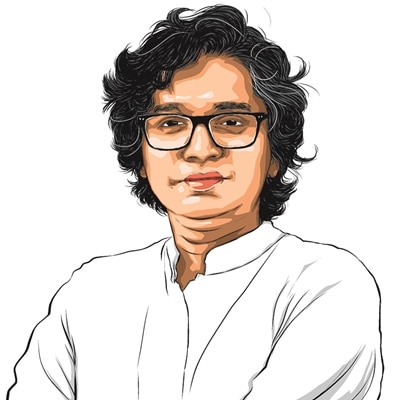Opinion Why I should be allowed to not celebrate the Ram temple consecration in Ayodhya
Those who celebrate the temple and those who distance themselves — the rights of both need equal protection
 Flower petals being showered at the Ram Mandir during the 'Pran Pratishtha' ceremony, in Ayodhya. (PTI Photo/File)
Flower petals being showered at the Ram Mandir during the 'Pran Pratishtha' ceremony, in Ayodhya. (PTI Photo/File) On January 22, the Ram Temple in Ayodhya was consecrated by the Prime Minister of India. The moment has been discussed as being phenomenal and as a watershed moment in Indian politics. In the conversation around the politico-religious significance of the consecration of the temple, however, the question of whose temple it is and who can safely distance themselves from it, remains unaddressed.
The ruling governments of India have made it clear that the Ram temple in Ayodhya is a national project. Since the Supreme Court judgment, the government has pushed a narrative of “national heritage” around it. The explanation of design and construction of the temple involved nationalist rhetoric. This included stories about material and labour sourced from across the country, the design being representative of all Indian cultures, the involvement of institutes of national importance such as IIT Chennai and CBRI at IIT Roorkee and contribution from some of the biggest names in the construction industry.
The consecration conducted by the PM featured performances by some of the best known artists, and was attended by popular celebrities who are household names. Institutionally, weeks before the consecration, government employees were given leave on the 22nd to take part in the celebrations, some universities issued notices barring protests, and businesses were urged to stay closed. The phrase “Ram sabke hain” (Ram belongs to everyone) became part of a widely dispersed rhetoric.
The truth is, India is home to huge minority populations who do not believe in the divinity of Ram. Several traditions and sects — especially Dalit and Adivasi groups — do not believe in this nationalised homogeneous version of Ramayana, and the Ram temple might not be a site they identify with. For a large population in India, Ayodhya might be a site of fear, violence and destruction. We must recognise that the temple is a religious site for one religious group in India — a country that has a secular Constitution and is home to the second largest Muslim population in the world. We must remember that the land for the temple was recognised as a temple site in a court judgment over a title suit. That verdict did not grant it a national status and the socio-political constitution of India does not allow for it either.
Making the Ram temple a national project concretises Brahminism as the official doctrine of the Indian state. The nationalisation of the temple sends a message that those who do not identify with this particular narrative of Ram are not part of the nation. The consecration — conducted in this language of nationalisation — is the beginning of a paradigm where other faiths of India (especially Islam), belong to an inferior citizenry.
Over the last month, we saw this paradigm unfold in the built environment. Groups of volunteers went door to door distributing stickers, pamphlets and flags to mark homes and shops as assumed participants in the celebrations. Our cityscapes were painted saffron with flags and hoardings marking every structure. It was made to appear through markers in our neighbourhoods and streets that everyone in India is rejoicing in the consecration of the temple.
Here, it is important to remember social scientist Paul Brass. Brass had conceptualised the idea of “mini Ayodhyas” in cities of India. These are, according to Brass, small structures around which a narrative of conflicted claims is locally spun, and this mimics the national Ram temple-Babri masjid conflict. In Brass’s mini Ayodhyas, micro-environments of confrontation, at local scales, are created through claims on mazars and mosques as being “originally” temples and social cleavages are manifested as violence. Violence is also produced through acts of provocation such as throwing bovine meat in the temple or pork meat in the mosque. Therefore, like in Ayodhya, conflict is generated through destruction and desecration of architecture.
Brass’s mini Ayodhyas have come full circle. Government orders, national narratives, and saffronised cities are pushing a wedge in India’s fault lines — this time through construction and consecration and not destruction and desecration. The site is the same and the object remains architectural, but while in 1992, it was acceptable to distance oneself from destruction, today, nobody can resist or deny being joyous and proud. Because if you do, you belong to the wrong group — the “other” of the nation state. Last month, our cities were marked to know who is not celebrating the consecration of the temple. Urban pockets, again, are mimicking Ayodhya, albeit this time in celebration. It was not the flag that marked houses, it was the absence of the flag that spatialised othering.
In this moment, we need to cultivate and protect a space where I can distance myself from the temple, where I can say that this is not my heritage, not the architecture I identify with, and where I feel safe in doing so. While the judgment of the Supreme Court is accepted and respected, we should resist the act of making a national icon of the temple in Ayodhya. We must protect the right to distance ourselves from the temple and still be identified as a citizen of India — no more and no less than those who partake in its celebrations. We must protect the right to say “not in my name” to the temple, and its consecration.
The writer is an architect and a graduate scholar of South Asia at University of Oxford




